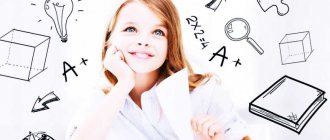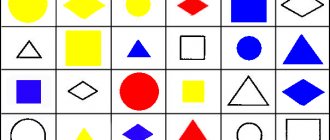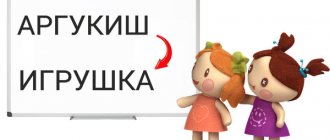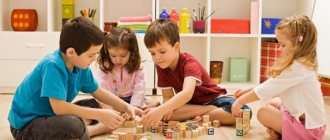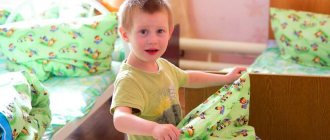Features of the development of thinking in preschool age
Children's thinking is characterized by a qualitative originality that distinguishes it from the thinking of adults. The development of thinking in preschool age is included in subject-related activities. A preschooler gains knowledge and experience through actions. These actions develop into ready-made schemes, are appropriated by the child (internalized) and become the basis of intellectual activity.
But the child not only uses ready-made connections that are familiar to him from actions with objects, but is aimed at establishing new relationships for him. A preschooler doesn’t just try on construction kit parts; selects a suitable object to “feed” the doll; builds a garage for his car - all these actions require analysis, comparison, generalization. That is, the child thinks, reflects.
The formation of a preschooler’s speech skills has a tremendous impact on the thinking process. Speech arises from the child’s need to communicate and interact, and then it acquires the functions of thinking.
In the first years of life, adult speech helps the child organize thinking and keep it in accordance with a specific goal. “Which ring in the pyramid will be next? Is it suitable? - the mother asks questions to the baby, and in response he tries to understand why one ring fits and the others do not.
The formation of active speech of the preschooler himself rapidly changes the conditions for the development of thinking. Now the child can ask a lot about what piques his interest. And the appearance of numerous questions is not long in coming.
Receiving answers, the baby finds out hidden characteristics and connections of objects that are not obvious to him, and children's thinking acquires elements of criticality and planning.
From younger to older preschool age, the internal mechanisms of the thinking process change. If in a small child the thought process is triggered by actions, then after 5 years a preschooler begins to actively operate with images.
Stages of development of preschoolers
Preschool age is a period of rapid development. At this time, the child learns to control his body, speech, perception, attention, memory, imagination develop, the emotional sphere and self-awareness are formed. This is the age of formation and development of mental abilities in children.
Infancy stage (birth to 1 year)
At this age, the child masters coordination, develops sensual (sensory) perception of the world - hearing, vision and touch, which will further influence the physical, mental and mental development of the child. There is an accumulation of experience. By the age of one year, the child pronounces only individual sounds, but understands almost all the words that you say to him.
Early childhood stage (1 year to 3 years)
The child becomes more autonomous, he has already enjoyed his first victories, so he continues to develop skills and abilities with pleasure. This is the age of “whys”.
Preschool stage (3 to 7 years old)
The child learns to defend his opinion and show character. The first attempts at conscious control of the emotional sphere appear.
Photo source: https://www.shutterstock.com/
Basic forms of thinking of preschoolers
The famous researcher of child intelligence, Jean Piaget, defined the entire preschool age as a stage of specific operations. However, this stage does not end with the child entering school, but continues until the age of 11.
While living through this stage, children first gain the ability to build mental representations of objects and phenomena through actions. Then they discover the ability to imagine images and act with them internally. And almost on the threshold of school, they discover the ability to think logically.
Accordingly, from an early age until entering school, one can observe how the types of thinking in preschoolers consistently develop with the dominance of the most characteristic of their age:
- Visually effective
- Visual-figurative
- Verbal-logical
Each subsequent form of thinking does not displace the previous one. At each age level, the child thinks both in the way he is accustomed to and adds new approaches.
Visual-effective thinking
Once again, we emphasize that the development of a child’s thinking is triggered by action. “I do - I observe what I do - I begin to understand something” - this is how the mechanism of the simplest thought processes works. Therefore, it is called visual-effective thinking.
The baby’s mental attempts are tied to visual situations and reflect direct relationships between objects. For example, when scooping porridge with a spoon, almost every child intentionally or accidentally turns the spoon over so that the contents fall onto the table. This simple experiment allows him to understand how to use such cutlery.
The next discovery will be the shape of the spoon. It turns out that you can’t do without the concavity of this tool if you want to eat soup.
Thinking for a 3-4 year old child means performing certain actions and observing what is happening, and not remembering and reflecting.
Thus, gradually, visually effective thinking is formed as the discovery of subject connections - between the components and characteristics of one object, between different objects, etc. Thanks to the accumulated experience, the child’s type of thinking acquires important characteristics:
- abstraction
- generality
Distraction is manifested in the fact that the child identifies an important feature and begins to use objects variably. For example, a plastic disk has just served as the steering wheel of an imaginary car, and now a preschooler is using it as a plate from which he feeds a doll. In this case, the shape of the object tells the child how to use it.
Generalization of thinking lies in the use of the same object for different purposes. For example, a younger preschooler can put small toys in a bucket, and then shake everything out and try it on as a headdress or use it as a chair.
Visual-figurative form
Experience in practical actions is an indispensable step for the development of the next type - visually imaginative thinking.
Productive activities are especially useful for developing creative thinking. When intending to build, sculpt or draw something, a child at least vaguely imagines the result. This already contains an intellectual task: “I want to do it... But how can I implement it?”
What features should you focus on to draw an apple? Probably on its round shape. And to make it even more similar to the original, you should add a ponytail with a leaf.
The preschooler draws models of the objects he sees around him. And this is only possible if he notices important characteristics of objects, analyzes, establishes differences and similarities with other objects.
An important feature of visual figurative thinking is that a child can imagine a certain object and come up with its image using memories and using imagination.
This implies the main properties of the figurative form of thinking:
- mobility
- structural organization
Thanks to the mobility of thinking, a preschooler is able to supplement his ideas. It is enough to show the baby the long ears of the toy, and he will immediately recognize the hare. This property extends to the child’s recognition of any objects familiar to him by visible elements.
The structural organization of mental activity is clearly manifested in design. To build a model from structural parts, the child thinks about the relative position of the parts and determines the sequence of connections. Thinking, he looks for ways to create an image that would correspond to the plan.
Role-playing games effectively develop children's imaginative thinking. It is in such games that preschoolers try to create typical images, analyze and mentally imagine situations that truthfully reflect real life or correspond to fantastic plots.
Visual-effective and visual-figurative thinking are closely intertwined. The child is driven by cognitive activity. He experiments, and thanks to actions and images, he discovers relationships, signs, characteristics, features in the world around him. These types of thinking bring the preschooler closer to understanding objective logical laws.
Exercises and games
The development of thinking in preschool children is carried out through various exercises.
To achieve a good result, you must follow certain rules:
- Regularity - you need to practice constantly so that the child can consolidate the acquired knowledge and skills. We are not talking about daily classes, but you need to set aside a couple of days a week;
- The development of thinking in children is associated with speech, so it is important to replenish their vocabulary, and, if necessary, study with a speech therapist or defectologist;
- Activities should be varied so that the child does not get bored and lose interest;
- Make sure that at the time of classes he is in good health and does not have colds or other diseases;
- Do not insist or force you to study if you have no desire or are in a bad mood;
- If there is a concomitant pathology that affects thinking abilities, the future student should be observed by an appropriate specialist - a psychologist, neurologist, psychiatrist and receive treatment;
- The thinking of preschool children will develop well with the help of games;
- Introduce educational elements into games: teach them to distinguish good from bad;
- Take breaks - there is no point in overtiring. The duration of classes should not exceed 15 minutes.
Development of a visually effective type
In early preschool age, initial attempts at logical reasoning only appear. During this period, games with sorters, modeling, drawing, activities and games with various materials - sand, different types of paper, cereals - are suitable. One of the main tasks of parents is to create all the conditions so that the baby can safely explore the world. It is not recommended to constantly come to him with advice and help: give the baby independence.
Development of imaginative thinking in children
The development of imaginative thinking in preschool age is especially favorably influenced by drawing and design. You can conduct role-playing games when children learn to create typical images through analysis and mental representation of the situation they have encountered in life. He can also supplement them with a fictional, even fantastic plot.
The active development of thinking in children at this age is facilitated by pictures, on which the baby will build his reasoning and expand his vocabulary. Help him formulate the right judgment, find signs that matter, but, as before, leave him the opportunity to express himself. Join the game only when you see blunders.
Development of logical thinking in children
This stage begins in senior preschool age. The kindergartener builds a logical sequence or stages of his actions, decides for himself what the place for play will look like, and draws up his own conclusions. At this age, the stock of knowledge is actively replenished, new skills appear: analysis, generalization, abstraction.
Popular exercises
“What does it look like?” Show a picture with a shapeless blot. The student names associations.
“Name the characteristic.” You show the object, and the baby must name its signs, the more, the better.
"The fourth is odd." Offer 4 pictures, one of which is redundant. The child must find similar features in three pictures and distinctive ones in the fourth. At the same time, he can reason out loud. Or there are several things in the picture, you need to name the extra one. Another variation - one object is missing in a number of pictures, you need to name it.
"Identify the owner." You name several characteristic features of an object or event, and the preschooler must guess the hidden word. “Multi-colored, in the shape of an arc, in the sky - a rainbow”, “needles, paws, nose - a hedgehog.”
"Find the picture." You and he have the same set of pictures or cards. You take out one picture and describe what is shown there. The preschooler must show his own similar picture. Then you change places. This game is suitable for a group of children to play with each other.
“Call it in one word.” You name the words, he needs to guess the general concept. “A table, a chair, a bed are furniture”, “A hare, a squirrel, a wolf, a dog are animals.” A variation of this exercise: an adult lays out different things or their images, the student groups them and collects toys in one group, clothes in another.
"Guess the mystery." One group of children thinks of a word, the other must guess it. You can ask questions about the subject, but the answers can only be “yes” or “no.”
"Help the alien." One of the children plays the role of an alien who knows nothing about earthly life. The guys explain to him the meaning of things and how to use them. If the child is singular, you will have to become an alien. The game develops children's thinking, expands their vocabulary, teaches them to compose sentences coherently and reason logically.
“Make a proposal.” Name several words related to one item. The baby must make a proposal. “Spoon, food - with the help of a spoon we eat.”
Matching games. Lay out pictures, for example, animals and their favorite food (bear - honey, squirrel - pine cones, cat - milk). The preschooler makes these pairs. Variants of this game include animals and their homes, tools and what they do with them, mothers and babies.
“Continue the row.” Draw beads in multi-colored beads. The student must continue the drawing, following the sequence. If you have a set of beads, you can string them: this will be even more useful, as it develops fine motor skills.
"Opposites". You name a word, the baby finds its opposite. “Big - small”, “good - evil”, “black - white”.
"Guess the object." You choose a thing that is in the room, describe it, the baby must guess what it is about.
"What's missing." Lay out several items. Ask the baby to close his eyes, during this time you remove one thing: the preschooler must remember the location of things and name what is missing.
If you don’t have time to come up with a game, you can use ready-made sets. For example, thinking in preschool children is perfectly developed by puzzles, Sudoku, and rebuses. Of course, choose them according to age and gradually make them more difficult. Older preschoolers may like chess, checkers, and dominoes.
A child’s thinking is the result of the child’s mental work and the upbringing of his parents, a fascinating process of learning about the world around him. Choose your exercise program, alternate them, so that training is easy and fun.
Conclusion
The preschool period is a part of life when a person acquires new skills, knowledge and abilities, reveals talents, and develops intelligence. One of the most important mental functions is thinking, which helps him in this process. Thinking in preschool children develops according to its own rules.
Educational activities must be carried out taking into account not only the age, but also the individual characteristics of your future student. Train his thinking abilities, give him freedom of action in exploring the world. Do not forget about upbringing, but do not create restrictions around that will not allow the baby to use his full potential.
Don’t focus on the result: the main thing is that both you and your child enjoy the activities together. It is not necessary to set aside separate time: you can come up with tasks while you are walking outside, preparing food, or swimming. This way you will spend your time not only interestingly, but also usefully.
